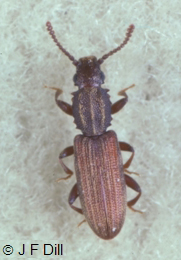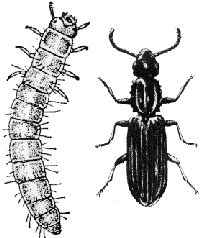Grain Beetles
Pest Management Fact Sheet #5034
James F. Dill, Pest Management Specialist
Clay A. Kirby, Insect Diagnostician
For information about UMaine Extension programs and resources, visit extension.umaine.edu.
Find more of our publications and books at extension.umaine.edu/publications/.
Description & Biology
Tiny sawtoothed grain beetles and the closely related merchant grain beetles are found throughout the world. These beetles attack such foods as cereals, breakfast foods, biscuit mixes, sugar, macaroni, flour, rice, dried meats, and dried fruits. They are primarily found wherever these dry foodstuffs are stored. Their presence in food makes it undesirable for human consumption, but no diseases are associated with the insects. The beetles are unable to break or eat through hard-shelled seeds such as corn, but they may be found in grain containing broken kernels or in processed cereal products.
Grain beetles are most likely to be found in foods that are stored for long periods. Food containers that are replenished without first emptying and cleaning the containers are susceptible to infestation. Cereals and flours are most likely to be infested.
The adult beetles are brown and about a 1/8″ (2.5 mm) long. Their flat, narrow bodies make it easy for them to enter cracks in storage areas or packaged materials. The thorax (the middle section of the beetle’s body) has saw-like projections on each side. The merchant grain beetle is capable of flight but the sawtoothed grain beetle is flightless. The worm-like larva is yellowish white, with a black head and three pairs of legs. A mature larva is about 1/8″ in length.
- Grain Beetle larva and adult
The adult sawtoothed grain beetle female lays up to 300 eggs, singly or in small batches. The eggs hatch in about eight days. In about 37 days, after molting between two to four times, the larvae are fully mature. The pupal stage lasts about six days. Under ideal conditions, this insect can complete its life cycle (egg to egg) in 27 to 52 days. Six generations per year are easily possible under normal conditions. The merchant grain beetle has a similar but shorter life cycle, and the females lay only about 1/2 to 2/3 as many eggs compared to the sawtoothed grain beetle.
Management
Sanitation
To control sawtoothed and merchant grain beetles, first try to locate the source of infestation. Remove all dishes and food from cabinets and check for signs of insects. All insects in food should be killed before the food is discarded. Infested foods packaged or stored in paper, waxed paper, metal, and some glass containers can be placed in an oven for one hour at 135°F or in a freezer at 0°F for six days to kill all stages of the insect. After removal of the foods, thoroughly vacuum all cabinets, drawers, etc., with special attention to cracks and crevices. Always be sure that the insects in food or in the vacuum bag are killed or confined so that they cannot escape to start another infestation elsewhere.
To lessen the chances of grain beetle infestations, store food in glass, plastic or metal containers with tight-fitting lids.
If you find beetles in newly purchased foods, report the infestations to the place of purchase such that the problem can be traced to its source and remedied. Remember that the trend toward home-use of raw and un-ground grains increases the likelihood of infestation by grain beetles and other pantry pests.
Infested cat, dog, and bird food can be used after the hot or cold treatment has been done.
Insecticides
If you use an insecticide, select a ready-to-use product that is labeled for the insect and location in which you plan to use the material. Some labelled materials include cyfluthrin, permethrin, and tetramethrin. For beetles, do not bother to spray walls, ceilings and shelves; these insects generally prefer cracks and crevices and other undisturbed places.
Do not spray food, dishes, cooking equipment, or areas that will come in contact with food. After the pesticide has dried, cover the shelves with paper then replace utensils and uninfested foods. After about one week, it might be advisable to spray the cracks and crevices one more time, especially if you see more larvae or adult beetles.
When Using Pesticides
ALWAYS FOLLOW LABEL DIRECTIONS!
Pest Management Unit
Cooperative Extension Diagnostic and Research Laboratory
17 Godfrey Drive, Orono, ME 04473
1.800.287.0279 (in Maine)
Information in this publication is provided purely for educational purposes. No responsibility is assumed for any problems associated with the use of products or services mentioned. No endorsement of products or companies is intended, nor is criticism of unnamed products or companies implied.
© 2016, 2018, 2020 | Reviewed & Revised: 2023
Call 800.287.0274 (in Maine), or 207.581.3188, for information on publications and program offerings from University of Maine Cooperative Extension, or visit extension.umaine.edu.
In complying with the letter and spirit of applicable laws and pursuing its own goals of diversity, the University of Maine System does not discriminate on the grounds of race, color, religion, sex, sexual orientation, transgender status, gender, gender identity or expression, ethnicity, national origin, citizenship status, familial status, ancestry, age, disability physical or mental, genetic information, or veterans or military status in employment, education, and all other programs and activities. The University provides reasonable accommodations to qualified individuals with disabilities upon request. The following person has been designated to handle inquiries regarding non-discrimination policies: Director of Equal Opportunity, 101 Boudreau Hall, University of Maine, Orono, ME 04469-5754, 207.581.1226, TTY 711 (Maine Relay System).



